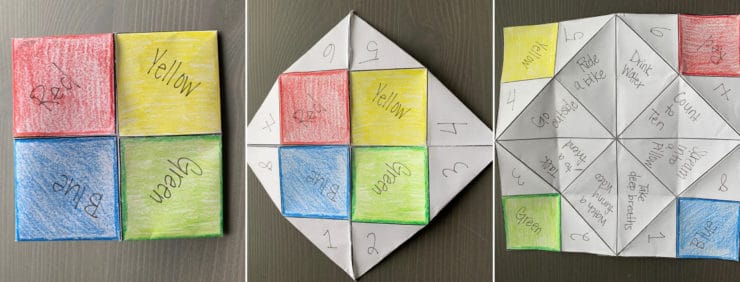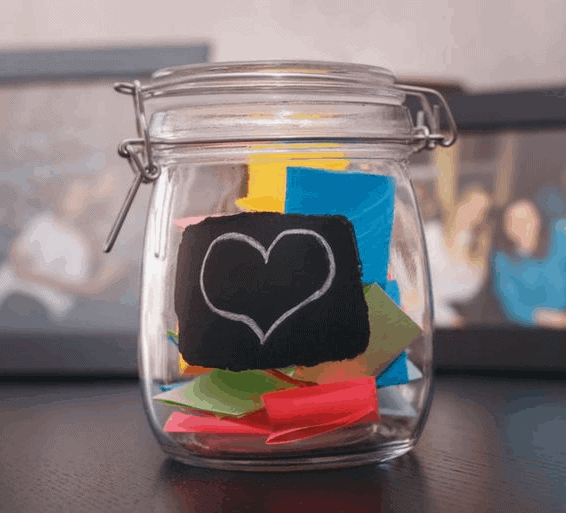Grief does not happen in a vacuum, and it can come no matter what other circumstances life has thrown at you. Your grief emotions may even be heightened by the anxiety of the moment we are all experiencing during the coronavirus pandemic. On top of that, many of you may be home with your children, looking for creative ways to be together and pass the time. We wanted to share a few ideas of activities that serve as grief outlets for you and your children and can also help you connect as a family.
Activity #1: “Coping Catcher”
This fortune-telling toy may be familiar to many of you from your own school days. This project combines learning and practicing new coping skills in a simple craft. During this moment of uncertainty, it can be a good idea to brainstorm coping techniques as a family and help keep each other accountable for using them.
- Step 1: Brainstorm Coping Skills as a Family
- Using a white board or other writing surface, jot down your family’s coping skill ideas from this brainstorming session! Coping skills can range from simple tasks, requiring no props, to more complex tasks. Continue to set boundaries of what is appropriate for your family during this activity – for example: Is screen time an acceptable coping method for your family? If so, make it time-oriented, like “Watch one funny YouTube video.” As you make your list, think of the different categories of things that can help you feel calmer or more at ease: things to do alone, things to do with others, physical activities, intellectual activities, etc.
- Here are few ideas to get your list started:
- Take 10 deep breaths
- Blow bubbles
- Draw a picture
- Video chat with a family member or friend
- Read a book
- Go on a walk
- Do some stretches
- Step 2: Print a “Coping Catcher” (click here to download the template) or make your own!
- Step 3: Follow these instructions for folding
- Step 4: Create your Coping Catcher
- On the outermost squares, children will write the name of a color. On each of the first interior triangles, they can write a number of their choosing. On the interior flaps, children will pick different coping skills and write one in each triangle. They may then decorate their Catcher.
- Step 5: Refold and play the game!
- If you’ve never played with a Coping Catcher before, it is simple. With thumb and forefinger inserted into the folded catcher, one participant picks a color from the outside of the catcher. The holder spells out that color while moving fingers in time with the spelling (see – you get to work on sight reading at the same time!). Next, with the catcher open, the participant picks a number, which the holder then counts out, again moving fingers in time with the counting. Lastly, the participant picks another number, and the holder opens the catcher and reads which “fortune” or in our case Coping Skill is listed under that number.
Try this out as a family and let us know what you think! Did you come up with any new coping skills to use at home? Did you have fun coloring your Coping Catcher?
Activity #2: Question Jar
This is an activity we have done before with our families and groups. Even if you have done it before, you can always update or add to it!
You don’t need any supplies other than pen and paper, but this activity can be made more fun if you have a spare mason jar lying around. You can decorate the jar with ribbon, stickers, or put fabric on the top. Then, fill the jar with open-ended questions. What is an open-ended question and why is it important? Open-ended questions cannot be answered with a simple “yes” or “no.” They usually begin with words like What, How, When, Where. These are the questions that really get a conversation started and can save you from stilted, one-word answers.
- Step 1: Sit down with your children and write down open-ended questions on slips of paper to put in a bowl (or your decorated mason jar).
- Step 2: Pull out the questions at downtime or mealtimes to help start a conversation. The questions can range from silly in nature to serious or meaningful questions about your loved one who died.
Check out our list for some ideas to get you started!
Share your favorite open-ended questions with us! What was something that got the discussion started in your home?
We hope these activities can bring you a little slice of The WARM Place until we can all be together again. Know that we are thinking of you and continue to be here to support you during this time!

